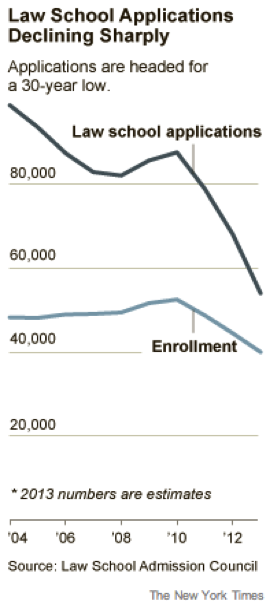According to a recent report by the Law School Admissions Council, nearly 11 percent fewer people took the LSAT this October than the year before. What’s more, these 33,673 test takers represent a steep drop of 45 percent since the test-taking peak in 2009. When paired with declining attendance at recent LSAC Law School Forums – basically, law school fairs – the numbers reflect a continuing disillusionment with the legal field.
And indeed, the job market for new lawyers is sobering to say the least. According to annual job placement data released by the American Bar Association, an average of only 56 percent of the class of 2012 found full-time legal jobs within nine months of graduation. The figure reflects stagnation over the last year, with 55 percent of the class of 2011 finding jobs within the same time period. Perhaps fittingly, the New York Times reported earlier this year that law school applications from aspiring JDs are on pace to hit a thirty year low. Of course, these averages can be misleading; 14 top law schools report job placement of over 80%, with University of Chicago, UVA, and UPenn topping the list with a 95% employment score. Additionally, while applications are declining, enrollment has shown only a modest decline:
Law school is no longer the safe haven it once was to sit out an economic downturn. There are no guarantees of job placement, even at the top schools. The profession, however, is taking steps to self-regulate. Law schools are addressing the current status of the profession by cutting the size of their incoming classes, thereby decreasing the excess supply of lawyers. Additionally, an ABA study last year showed that law schools are altering their curricula to increase instruction in professional skills through clinical work, simulations and externships.

